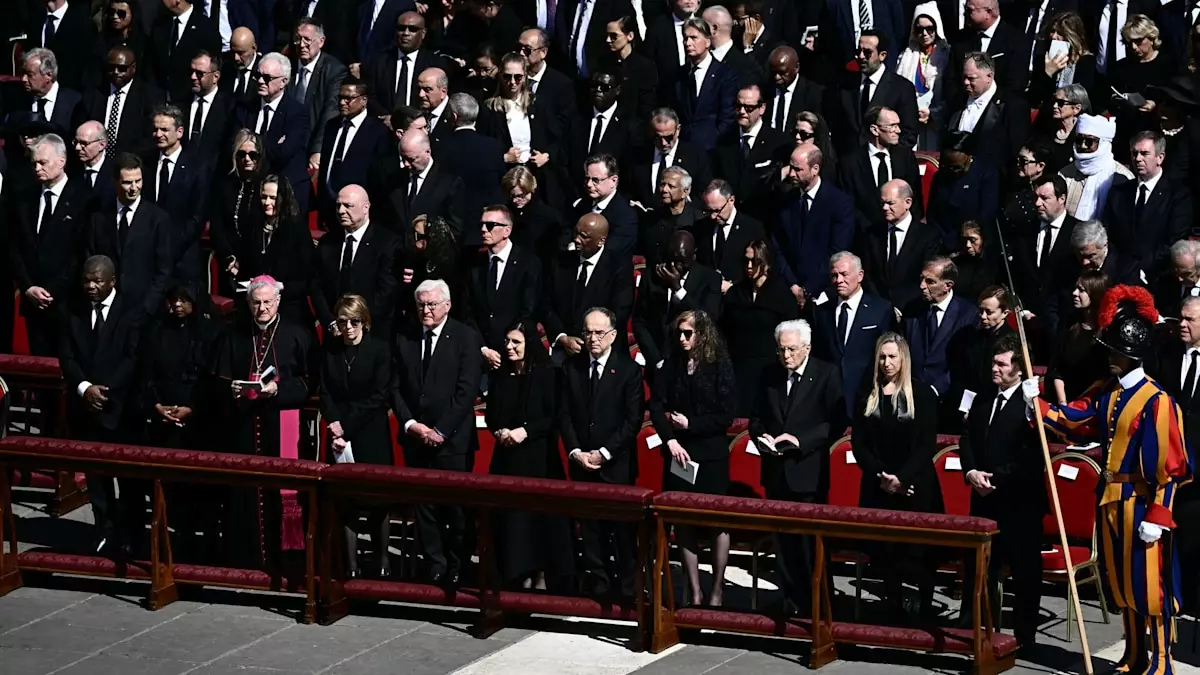In a world where symbolic gestures and public appearances can influence global perceptions, the seating arrangements at the funeral of Pope Francis in Vatican City tell a compelling story of diplomacy, hierarchy, and the intricate dance of modern-day royal engagements. The bewilderment among royal watchers surrounding the positioning of Prince William and UK Prime Minister Sir Keir Starmer not only highlights the quirks of traditional etiquette but also peels back layers of understanding about the carefully choreographed nature of international representation.
A Striking Contrast in Seating Arrangements
At first glance, the sight of Prince William, Duke of Cambridge, standing several rows behind a cluster of world leaders sounds almost inconceivable, especially given his status as a senior member of the British royal family. One might assume that his place would be at the front, perhaps alongside figures like US President Donald Trump and Queen Mary of Denmark, who comfortably occupied seats closer to the altar. However, the arrangement was driven not by hierarchies or pecking orders but by an unexpected twist: an alphabetically ordered seating plan executed in French, the nuanced language of diplomacy.
In an event where the presence of heads of states and royalty converged, the focus on alphabetical order in a language foreign to many underscores a greater intention. Amid the intricate dance of politics, the Vatican’s seating plan aimed to neutralize the ingrained hierarchies often found in international gatherings. As Cardinal Vincent Nichols suggested, the scheme was a “master plan” tailored to address “big egos,” indicative of a deep understanding of the nuances involved in managing global leaders’ perceptions.
The Diplomatic Language of Seating Plans
This careful orchestration may seem trivial on the surface, yet it reveals a profound respect for the rituals inherent in diplomatic practice. Cardinal Nichols’ remarks shed light on an age-old strategy intertwined with the history of the Catholic Church, often reliant on both power and symbolism. The choice of alphabet and language signals an awareness that, in diplomacy, perception can be just as impactful as reality. Keeping ranking and title influences at bay allows dignitaries to encounter each other on what can be perceived as a level playing field, even if such a scenario remains an illusion.
Importantly, the seating arrangements at the pope’s funeral reflect more profound implications for how royal families and political figures engage in contemporary ceremonial contexts. The careful planning behind the arrangements means that, while ostensibly equal, attendees remain acutely aware of their positional placement—a subtle reminder of the ever-present undercurrents that define international relations.
The Role of Tradition and Modern Protocol
In his capacity as a representative of King Charles III, Prince William’s attendance at the funeral was heavily guided by royal tradition. This act of representing one monarch’s faith in a different religious context serves as a potent symbol of the complexities within the Anglican and Catholic Churches. Charles himself had previously participated in similar duties, attending Pope John Paul II’s funeral on behalf of his mother, Queen Elizabeth II.
These appearances signify a softened approach towards interfaith relations, while still inherently grounding themselves in long-established royal rites. The absence of the Princess of Wales, likely due to family commitments, remains emblematic of the balancing act that modern royals must negotiate between their public personas and private lives. While anticipated royal attendance can amplify an event’s significance, it further accentuates the individualized relationships and commitments that family members hold beyond the public eye.
Managing Public Sentiment Amidst the Grandeur of Tradition
The art of statecraft is intrinsically tied to public sentiment, especially within a space that reveres tradition as much as the Vatican does. Prince William’s relegated position in the seating arrangement and the ceremonial tragedy surrounding the pope’s passing resulted in significant media scrutiny, which in turn reflects the audience’s desire to extract narratives of power dynamics.
Just as the Vatican and its machinations reflect centuries of tradition, contemporary royals are tasked with adapting these historical narratives to fit a modern ethos centered around inclusivity and shared values. The balance between honoring the past while navigating public expectations is a tricky one, implying that every choice made—down to seating arrangements—carries weight beyond its immediate context.
In essence, the seating plan at Pope Francis’ funeral is reflective of a larger narrative regarding diplomacy, rank, and the complex interplay of religious and royal responsibilities. It serves as a microcosm for broader discussions on the evolving role of monarchy and the ever-changing expectations of leadership in a globalized world.

